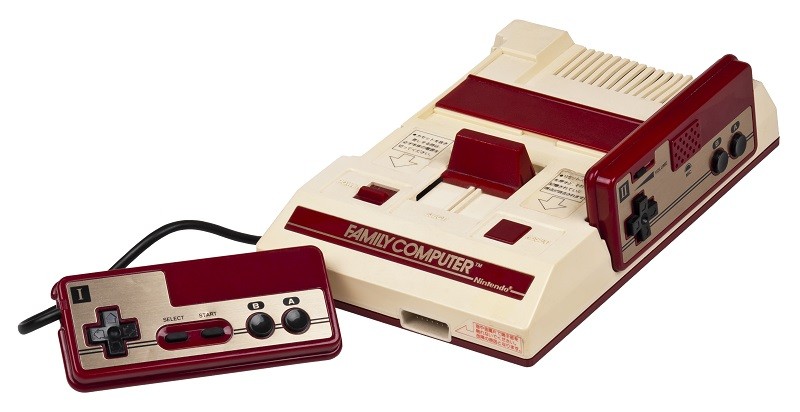
Nintendo Family Computer System (Famicom). Image from Wikipedia.
News that the original Famicom Nintendo game console, first released in 1983, is now being taught in Japanese social studies class has sent shockwaves throughout Japanese social media.
A post by Twitter user @moriteppei announcing the news received a stunning 32,000 re-Tweets:
六年生の子が「あ、ファミコンだ!」と言うので「その年で知らんだろ」と言ったら「知ってるよ!社会で習った」と言われる。 _人人人人人人人人人人人人_ > 社会で習った! <  ̄Y^Y^Y^Y^Y^Y^Y^Y^Y^Y^Y ̄ pic.twitter.com/RuTXMWW1q8
— 森哲平 (@moriteppei) May 6, 2015
My daughter is in the sixth grade. When she came across my old console she said “That's a Famicom!” I said, “You're way too young to have ever heard of a Famicom.” And she said, “Of course I know what that is. We learned about it in social studies class!”
WHAT? They're learning about Famicon in SOCIAL STUDIES CLASS???
The original Nintendo game console occupies a special place in Japanese pop culture.
Nearly 62 million of the pioneering electronic gaming consoles, called Famicom in Japanese and marketed as the Nintendo Entertainment System (NES) in English-speaking countries, were sold around the world until production ceased in 1993.

Super Mario Bros. first debuted in Japan on Nintendo's Family Computer System, marketed as NES outside of Japan. Screencap from YouTube user Pikachu upload.
For many Japanese adults in their forties who now have children of their own, the Famicom is a nostalgic reminder of childhood during the optimistic, booming “bubble” years of the affluent 1980s.
Even before @moriteppei's popular Tweet last month, other Twitter users were noticing Famicom's addition to elementary school textbooks in April, at the start of the school year in Japan.
昨日新しくもらってきてた小3の子どもの社会の教科書みてたら。昔のくらしのページにファミコンで遊ぶ子どもの写真のってた…。今の子にとったらファミコンが昔の暮らしなんやね。懐かしいけど遊んだけど。
— ゆり (@swingingYrtm) April 9, 2015
Yesterday my daughter brought home her new social studies textbook. In the section discussing how people lived life in the past there was a photo of kids playing a Famicom game. For kids these days, the Famicom is just part of how people lived once upon a time. It sure is nostalgic…
While parents were nostalgic, they also had to confront the fact that their own childhood in 1980s Japan now looks, from the perspective a child in 2015, “like an ancient relic”:
いや~まじで3年生の社会科の教科書に「ファミコン」が「お父さんお母さんの時代の~」て書かれてて、うんわ~~~~まじか~~~~確かに古いけどまるで遺物写真のように感じてしまってもう昭和ってそうなんか~~~~~
— かじか (@kajikatohituji) May 6, 2015
Wow, Famicom really is described in the Grade 3 textbook as “something from your mother and father's childhood.” I can't believe it. I suppose it was long ago, but the photo [in the textbook] makes the Famicom look like an ancient relic. I guess that's the 1980's looks like to us now.
社会で…習った…?!授業で…?もしかしてベーゴマとかメンコみたいにファミコンも「昔の遊び」扱いされてるの?!
— kga152 (@kga152) May 6, 2015
They're learning about Famicom in… social studies class? Famicom must be being taught as “one of those games kids used to play in the olden days” like playing tops (beigoma) or playing cards (menko).
Kyoto-based Nintendo itself got its start in 1889 making playing cards for children.

Menko playing cards for children, likely from 1920's or 1930's Japan. Image from Wikipedia.
Twitter user @azemin sums up the moment:
ファミコンが社会の教科書に出ているとは。歴史上の出来事になっているとは。当時遊んでいた人々も大袈裟だが、歴史上の人物と同等の扱いになってしまうのか。小学生にとってはファミコンは遊ぶものでは無くて、学校で勉強するもの。すごい時代になったと痛感する。
— azemin (@azemin) May 6, 2015
Famicom has entered the textbooks as a part of our history. I wonder if the people who grew up playing Nintendo may think it's all a little grandiose to treat Famicom with the same status as an historical figure. For elementary school kids, Famicom is not a toy, but something they have to study in school. What amazing times we live in.





